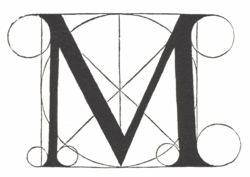- De divina proportione
-
 The first printed illustration of a rhombicuboctahedron, by Leonardo da Vinci, from De divina proportione.
The first printed illustration of a rhombicuboctahedron, by Leonardo da Vinci, from De divina proportione.
De Divina Proportione (About the divine proportions) is a famous book on mathematics written by Luca Pacioli around 1497 in Milan. Today only two versions of the original manuscript are believed still to exist. The subject was mathematical and artistic proportions, and the book was illustrated by Leonardo da Vinci.
Contents
The book
The book consists of three individual manuscripts,[1] which Pacioli worked on between 1496 and 1498.
The first part, Compendio Divina Proportione, studies and describes the Golden ratio from a mathematical point of view and also studies polygons.[1][2] The work also discusses the use of perspective by painters such as Piero della Francesca, Melozzo da Forlì, and Marco Palmezzano.
The second part discusses Vitruvius ideas on the application of mathematics in architecture.
The third part, Libellus in tres partiales tractatus divisus, is mainly an Italian translation of Piero della Francesca's Latin writings On [the] Five Regular Solids ("De quinque corporibus regularibus")[1] and mathematical examples.[2]
The book contains illustrations in woodcut after drawings by Leonardo da Vinci.[3] Leonardo drew the illustrations of the regular solids while he lived with and took mathematics lessons from Pacioli. Leonardo's drawings are probably the first illustrations of skeletonic solids which allowed an easy distinction between front and back.
History
On June 1 1509[3] the first printed edition was released in Venice by Paganinus de Paganinus. The clarity of both the written material and Leonardo's diagrams gave the book a popularity beyond mathematical circles.[4] The book has since then been reprinted several times.
Today only two surviving copies of the original print exist, one at the Biblioteca Ambrosiana in Milan and the second at the Bibliothèque de Genève in Geneva.
The book was displayed under an exhibition in Milan between October 2005 until October 2006[citation needed] together with the Codex Atlanticus.
The "M" logo used by the Metropolitan Museum of Art in New York City is adapted from one in De divina proportione.[5]
References
External links
Categories:- History of mathematics
- History of geometry
- Mathematics manuscripts
- Medieval literature
Wikimedia Foundation. 2010.


